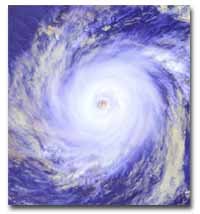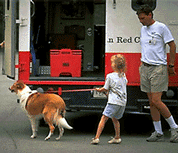|
What to do after the flood.
What is a Hurricane?
Do you have a Disaster Plan for Your Family?
- For Work ?
- For your Pet?
Get current hurricane
updates
Get current disaster
watch information
Disaster supplies kit
Bethany Beach Storm Cam

The "eye" of a typical hurricane,
like Hurricane. Isabel
Courtesy of NOAA.


|
|
Swimmers & Surfers:
The waves may look inviting, but don't be fooled. Hurricanes produce monster rip tides which are blamed for the deaths of many swimmers each year.
What is a rip tide: A rip tide is a powerful current with opposing forces that actually pulls the water out away from the beach in a sort of channel.
What to do if you are caught in the current: Stay calm! Don't fight it!
Swim in a diagonal angle back to the beach at a comfortable pace. The tide may draw you out further than you are used to, but it will eventually let go and you'll need all your strength to swim back in.
|
|
Are you ready?
Katrina may be gone, but the relief operation she spawned will continue for many months, possibly years, to come. And, while the Red Cross had been warning residents along the coast to prepare, few had even enough supplies for the requisite three days. Of course, few anticipated the possibility that it might take 5 or 6 days before rescuers could get into the disaster area. Of those who made it to shelter, many came without their medicine, their toothbrush, or even a change of clothes. A little preparation could have gone a long way.
Hurricanes are the largest of all storms, and are sometimes accompanied by one or more of the following weather hazards: storm surges, high winds, tornadoes, and/or flooding. Before the next hurricane strikes, you must be prepared for all of these possibilities:
Before the Storm...
Know the difference between hurricane watch and warning:
- Watch - Hurricane conditions are possible in the specified area, usually within 36 hours.
- Warning - Hurricane conditions are expected in the specified area, usually within 24 hours.
Prepare for high winds
- Install hurricane shutters or precut 3/4" thick marine plywood for each window of your home. Install anchors for the plywood and pre-drill holes for quick installation.
- Make trees more wind resistant by removing diseased or damaged limbs, then strategically remove select branches to allow wind to blow through.
As the Storm Approaches...
- Secure lawn furniture, decorations, hanging plants, and anything else that can be picked up by the wind -- bring inside anything which cannot be tied down.
- Prepare to cover all your windows with shutters or precut plywood as described above -- if you do not have plywood, do what you can to prevent shattering.
NOTE: Tape is not effective.
- Fill your gas tank in your car.
- Secure and double-check tie-downs on manufactured homes.
- Stock up on bottled water, canned goods, batteries, first aid supplies and medications.
When You're Caught in the storm...
- Listen to news broadcasts frequently - if they advise to evacuate, leave immediately!
- If you are not advised to evacuate, stay indoors, away from windows. Be aware, the calm "eye" of the storm is deceptive - the storm is not over. The worst part of the storm comes after the eye passes and objects damaged by the force of the first winds can be broken off and sent flying by the opposing force of the second winds.
- Watch for tornadoes which can occur during or after a hurricane.
- Remain in the center of your home, in a closet or bathroom without windows.
- Stay away from flood waters.
- Do not try to cross a flooded road, turn around instead.
- If waters are rising rapidly around you, leave your car and climb to higher ground.
What is a Hurricane?
A hurricane is a type of tropical cyclone, which is a generic term for a low pressure system that generally forms in the tropics. The cyclone is accompanied by thunderstorms and, in the Northern Hemisphere, a counterclockwise circulation of winds near the earth's surface. Tropical cyclones are classified as follows:
| Tropical Depression |
An organized system of clouds and thunderstorms with a defined surface circulation and maximum sustained winds* of 38 mph (33 kt**) or less |
| Tropical Storm |
An organized system of strong thunderstorms with a defined surface circulation and maximum sustained winds of 39-73 mph (34-63 kt) |
| Hurricane |
An intense tropical weather system of strong thunderstorms with a well-defined surface circulation and maximum sustained winds of 74 mph (64 kt) or higher |
* Sustained winds are defined as a 1-minute average wind measured at about 33 ft (10 meters) above the surface.
** 1 knot = 1 nautical mile per hour or 1.15 statute miles per hour. Abbreviated as "kt". |
Pets and Disaster: Be Prepared
|

